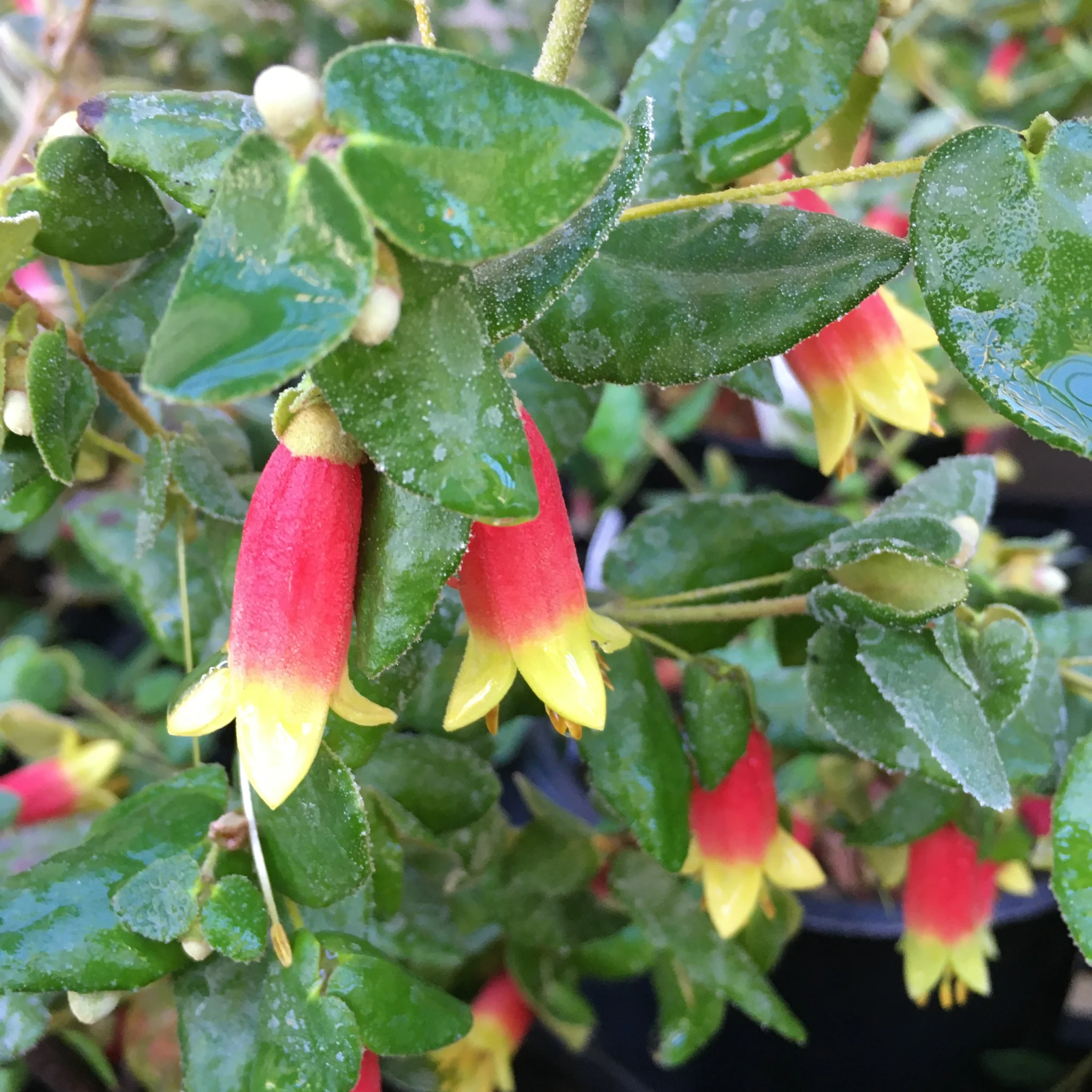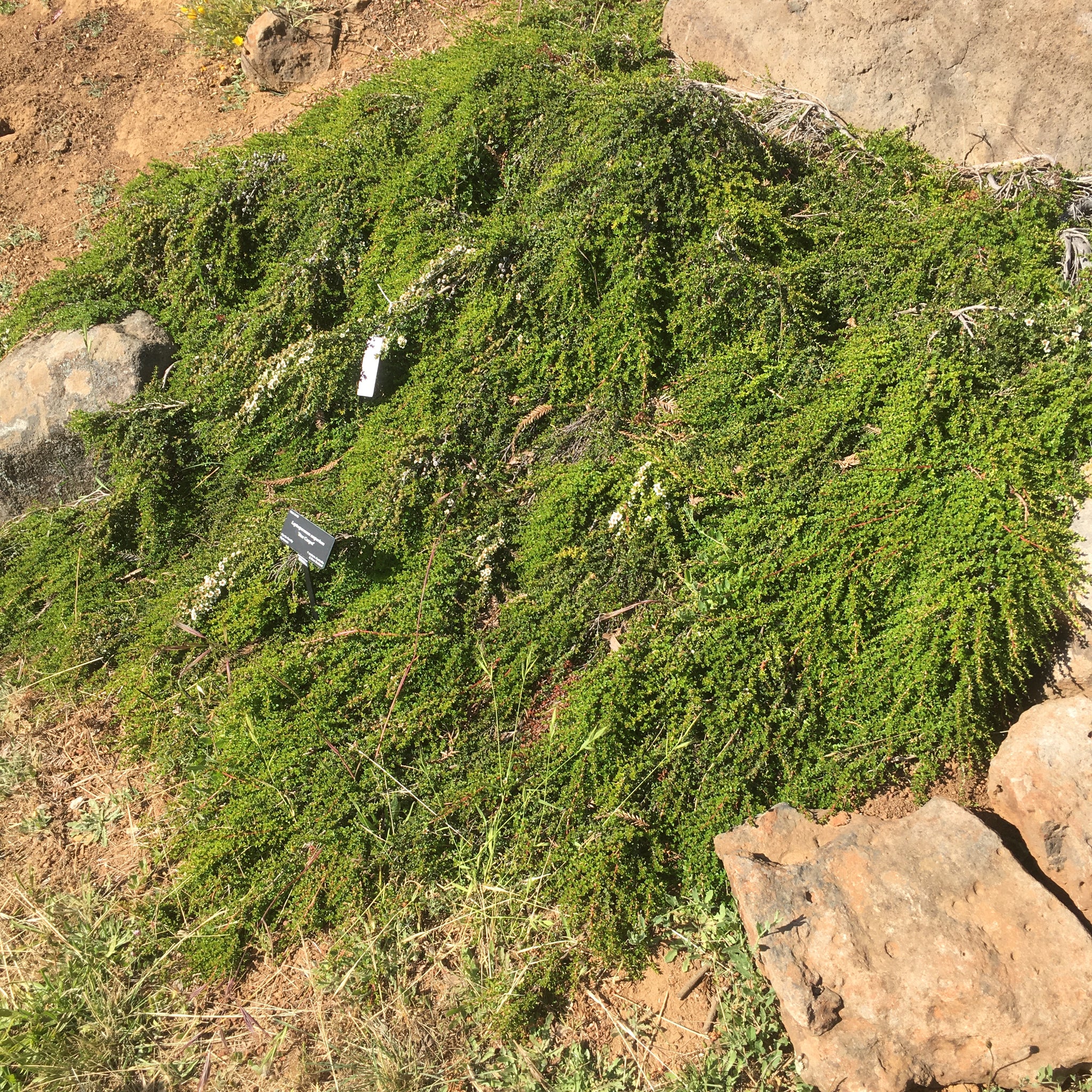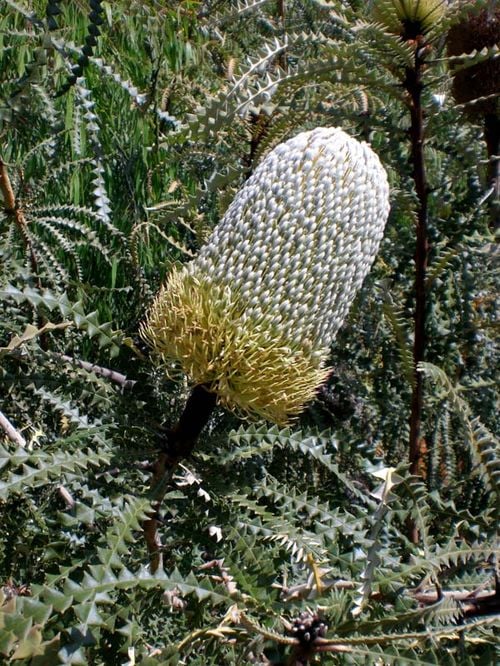Favorite Plants of
Pacific Plant People
Member Profile
Melinda Kralj

Melinda Kralj began as a volunteer at the University of California and worked her way up to become curator of the Australian plant collection – the largest of any outside of Australia – where she designed and helped install its distinctive Australian Rock Garden.

Correa reflexa ‘Cape Nelson’

Leptospermum scoparium ‘Star Carpet’
Banksia "Ric Rack Banksia"
Drought Resilient
Plant Family
Proteaceae
Genus
Banksia
Species
Banksia "Ric Rack Banksia"
This Banksia Brings Extravagant Flowers and Foliage. Spreading medium shrub to small ornamental tree 9-18'. Creamy-yellow long lasting flowers, with thin, silvery grey-green deeply toothed leaves. Flowers most of the year. Well-drained, light to heavy soils in open sunny position. Tolerant of alkaline soils. Drought and moderately frost tolerant. Grown commercially for cut flowers. Makes an attractive hedge or screen.

Water Use
Drought tolerant
Conditions When It Thrives
Well-drained soil, full sun
Ecosystem Services
Drought-loving once established
Native To
Western Australia
Geographic Range
Hardy to approximately 20-25 degrees Fahrenheit
Availability
Height & Habit
Can be grown as shrubs or small trees from 12-20’ tall.
Special Features
First Banksia species specimens were collected in 1770, and the genus was named by Carl Linneus in honor of Joseph Banks.
Why They Love It
Zig-zag foliage looks like it was pruned with pinking shears, otherworldly 1’ tall creamy yellow inflorescences bloom most of the year in Berkeley. They make great dramatic additions for floral arrangements.
Seasonal Appearance/Dormancy
Advice
Can tolerate sandy soil, but avoid direct salt spray. Avoid winter rains.
Correa reflexa ‘Cape Nelson’
Drought Resilient
Plant Family
Rutaceae
Genus
Correa
Species
Correa reflexa ‘Cape Nelson’
A Standout Correa. An evergreen shrub to 4 feet tall and wide that has small dark glossy olive green elliptic leaves that clasp the stems and narrow tubular lipstick-red flowers from fall through spring. Best in cool coastal sun to partial shade with good drainage. Drought tolerant once established but performs best with summer irrigation. Hardy to the mid to low 20°s F. This long blooming shrub is attractive to hummingbirds and can be pruned to shape or to keep smaller and adds interest to the mixed flower border or woodland garden in mass or as a single specimen and is good for container gardening. This plant originated from Kangaroo Island, Australia's third largest island, that is located 70 miles southwest of Adelaide at the entrance of Gulf St Vincent.

Water Use
Low Water Needs
Conditions When It Thrives
Full sun, well-drained, fertile soil.
Ecosystem Services
Pollinator-attracting, particularly birds, drought-loving once established
Native To
Victoria state, Australia
Geographic Range
USDA Gardening Zone 9
Availability
Height & Habit
Although some reports say it can grow 10’ wide, Kralj says this shrub gets 2.5’ tall x 4’ wide.
Special Features
Flowers are dangling trumpets in cerise with flared lemon tips. Elliptical leaves are olive-green.
Of all the Correas from the Cape Nelson are UC Santa Cruz Arboretum & Botanic Garden trialed, this showy performer won the right to be named as a cultivar. Also, Correas are in the citrus family, Rutaceae.
Why They Love It
Seasonal Appearance/Dormancy
Evergreen
Advice
Great for the front of the border, along paths, or in a pot where their foliage and flowers can be appreciated up close
Leptospermum scoparium ‘Star Carpet’
Drought Resilient
Plant Family
Myrtaceae
Genus
Leptospermum
Species
Leptospermum scoparium ‘Star Carpet’
Trailing Leptospermum Offers Summer fireworks Backed by Evergreen Foliage. A spreading evergreen groundcover that stays flat to the ground and grows to 6 to 8 feet wide but can be kept smaller with pruning. The stems are covered by quarter inch long sharp tipped sessile scale-like leaves that are bright green in new growth and darkening with age. In mid spring the plant is covered by the lightly fragrant single white flowers with greenish centers that present themselves well on the foliage, looking like stars against the dark sky.

Water Use
Medium
Conditions When It Thrives
Cold hardy to approximately 20 degrees Fahrenheit. Prefers slightly acidic, well-drained, fertile soil. Water well to establish while young, after which it is somewhat tolerant of drier conditions.
Ecosystem Services
Attractive to many pollinators, especially bees.
Native To
Australia and New Zealand
Geographic Range
Availability
Height & Habit
This evergreen groundcover creeps along the ground nearly flat, to about 7’ wide, with small glossy leaves making the perfect backdrop for the clouds of white single cupped flowers with lime green centers.
Special Features
The leaves are aromatic when crushed.
Explorer Captain James Cook gave his crew a tea from Leptospermum species to combat scurvy in 1768, hence the common name of ‘Tea Tree’. Manuka honey is made from Leptospermum blossoms.
Why They Love It
Melinda adores its beautiful, graceful texture as it drapes over a wall, festooned with white flower fireworks in summer.
Seasonal Appearance/Dormancy
Evergreen
Advice
Banksia "Ric Rack Banksia"
Drought Resilient
Plant Family
Proteaceae
Genus
Banksia
Species
Banksia "Ric Rack Banksia"
This Banksia Brings Extravagant Flowers and Foliage. Spreading medium shrub to small ornamental tree 9-18'. Creamy-yellow long lasting flowers, with thin, silvery grey-green deeply toothed leaves. Flowers most of the year. Well-drained, light to heavy soils in open sunny position. Tolerant of alkaline soils. Drought and moderately frost tolerant. Grown commercially for cut flowers. Makes an attractive hedge or screen.

Water Use
Drought tolerant
Conditions When It Thrives
Well-drained soil, full sun
Ecosystem Services
Drought-loving once established
Native To
Western Australia
Geographic Range
Hardy to approximately 20-25 degrees Fahrenheit
Availability
Height & Habit
Can be grown as shrubs or small trees from 12-20’ tall.
Special Features
First Banksia species specimens were collected in 1770, and the genus was named by Carl Linneus in honor of Joseph Banks.
Why They Love It
Zig-zag foliage looks like it was pruned with pinking shears, otherworldly 1’ tall creamy yellow inflorescences bloom most of the year in Berkeley. They make great dramatic additions for floral arrangements.
Seasonal Appearance/Dormancy
Advice
Can tolerate sandy soil, but avoid direct salt spray. Avoid winter rains.
Correa reflexa ‘Cape Nelson’
Drought Resilient
Plant Family
Rutaceae
Genus
Correa
Species
Correa reflexa ‘Cape Nelson’
A Standout Correa. An evergreen shrub to 4 feet tall and wide that has small dark glossy olive green elliptic leaves that clasp the stems and narrow tubular lipstick-red flowers from fall through spring. Best in cool coastal sun to partial shade with good drainage. Drought tolerant once established but performs best with summer irrigation. Hardy to the mid to low 20°s F. This long blooming shrub is attractive to hummingbirds and can be pruned to shape or to keep smaller and adds interest to the mixed flower border or woodland garden in mass or as a single specimen and is good for container gardening. This plant originated from Kangaroo Island, Australia's third largest island, that is located 70 miles southwest of Adelaide at the entrance of Gulf St Vincent.

Water Use
Low Water Needs
Conditions When It Thrives
Full sun, well-drained, fertile soil.
Ecosystem Services
Pollinator-attracting, particularly birds, drought-loving once established
Native To
Victoria state, Australia
Geographic Range
USDA Gardening Zone 9
Availability
Height & Habit
Although some reports say it can grow 10’ wide, Kralj says this shrub gets 2.5’ tall x 4’ wide.
Special Features
Flowers are dangling trumpets in cerise with flared lemon tips. Elliptical leaves are olive-green.
Of all the Correas from the Cape Nelson are UC Santa Cruz Arboretum & Botanic Garden trialed, this showy performer won the right to be named as a cultivar. Also, Correas are in the citrus family, Rutaceae.
Why They Love It
Seasonal Appearance/Dormancy
Evergreen
Advice
Great for the front of the border, along paths, or in a pot where their foliage and flowers can be appreciated up close
Leptospermum scoparium ‘Star Carpet’
Drought Resilient
Plant Family
Myrtaceae
Genus
Leptospermum
Species
Leptospermum scoparium ‘Star Carpet’
Trailing Leptospermum Offers Summer fireworks Backed by Evergreen Foliage. A spreading evergreen groundcover that stays flat to the ground and grows to 6 to 8 feet wide but can be kept smaller with pruning. The stems are covered by quarter inch long sharp tipped sessile scale-like leaves that are bright green in new growth and darkening with age. In mid spring the plant is covered by the lightly fragrant single white flowers with greenish centers that present themselves well on the foliage, looking like stars against the dark sky.

Water Use
Medium
Conditions When It Thrives
Cold hardy to approximately 20 degrees Fahrenheit. Prefers slightly acidic, well-drained, fertile soil. Water well to establish while young, after which it is somewhat tolerant of drier conditions.
Ecosystem Services
Attractive to many pollinators, especially bees.
Native To
Australia and New Zealand
Geographic Range
Availability
Height & Habit
This evergreen groundcover creeps along the ground nearly flat, to about 7’ wide, with small glossy leaves making the perfect backdrop for the clouds of white single cupped flowers with lime green centers.
Special Features
The leaves are aromatic when crushed.
Explorer Captain James Cook gave his crew a tea from Leptospermum species to combat scurvy in 1768, hence the common name of ‘Tea Tree’. Manuka honey is made from Leptospermum blossoms.
Why They Love It
Melinda adores its beautiful, graceful texture as it drapes over a wall, festooned with white flower fireworks in summer.
Seasonal Appearance/Dormancy
Evergreen
